Are we eating healthier now than our grandparents did in the 1970s?
Ultimately, obesity develops because of energy imbalance (calorific excess / deficit). So the major areas for intervention to control the onset of obesity relate to dietary intake, (portion size and composition) and energy expenditure (activity and exercise). Diet modification is one key approach to lowering the prevalence of obesity in the population, particularly the trend for a decline in physical activity and an increase in sedentary time. On the global level, changing technologies have played a role. These include cheap cooking oils, food processing, modern supermarkets, fast-food outlets, foods with excessive ‘empty calories’, and improved food distribution and marketing.

Diets back in the 1970s were different than they are today, reflecting changes in food availability, tastes and cultural practices. However, were the old 1970s diets really healthier and less prone to cause obesity than modern diets?
A related question is whether people simply ate more food because they ate larger portion sizes? Meals and servings have tended to get larger, especially for fast-foods and convenience foods.
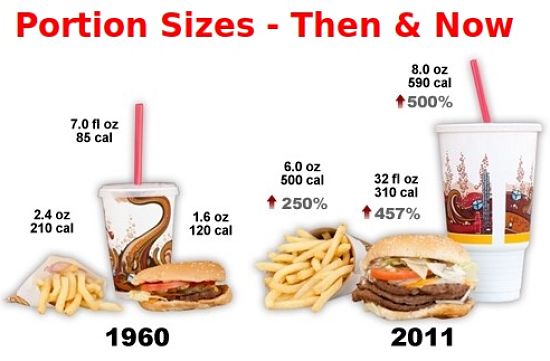
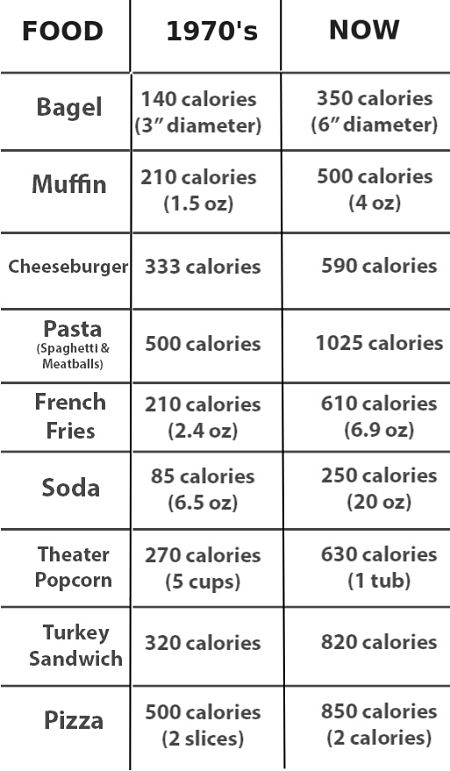
Another issue is whether people eating more calories because modern food is richer and with very calorie densities? Therefore, are people passively eating too many calories, without eating more food or junk food, because the food now available is so rich?
Does the increase in the availability of a huge variety of foods mean that potentially our diets should be better now than there were in the past?
Is it a two-edged sword - wider food choices have good and bad consequences - the good and bad choices have both expanded. Cheaper foods and cheap fast foods, combined with larger portions sizes, mean we eat more each meal, and more often via snacking on 'empty calories'.
The old expression; "You are What You Eat" is truer today then ever before, because we now have so many choices and such a huge variety of inexpensive and healthy food to choose from. We also have more opportunity for better lifestyle choices with reduced work hours and more leisure time.
Changes in Food Consumed in Western Countries over the Last 50 years
Food dishes eaten in United States, UK, Europe, Australia and New Zealand and other 'Western Countries' have certainly changed. Remember - Sausages and Mash, Meat and 3 Veg, Fish and Chips on Fridays, a Simple Lamb Stew, Rissoles and Hamburger, the classic Sunday Roast with Beef and Lamb. The food landscape in many countries has also changed remarkably in the last 50 years due to migration, globalisation and the adoption of Asian, Indian and Middle Eastern food and recipes in the West.
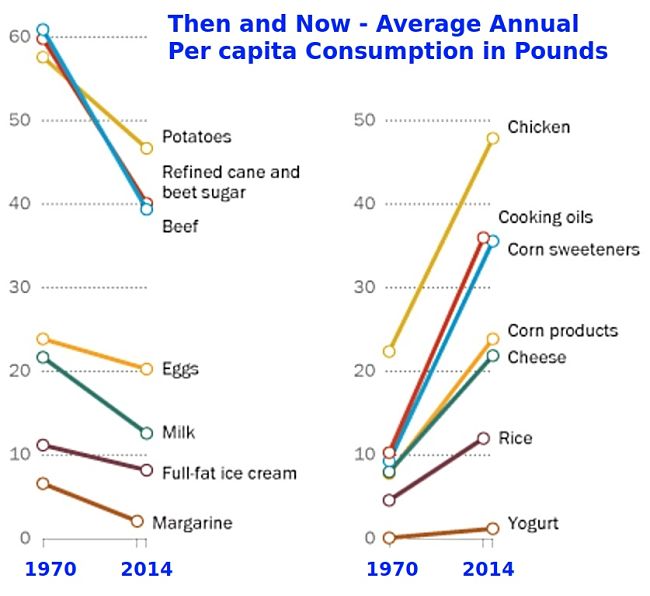
Below is a summary of some of the key changes which are also highlighted in the figures:
=> Meals were mostly eaten at home, cooked by mums, who made and cooked the meals from scratch, mostly from wholefoods, with packaged-food consumption very limited, apart from frozen peas. People, back then had a healthy diet - it was simple, home-cooked and unprocessed. It relied of what was locally and seasonally available. But, there was less variety, and fewer options. So was it healthier?
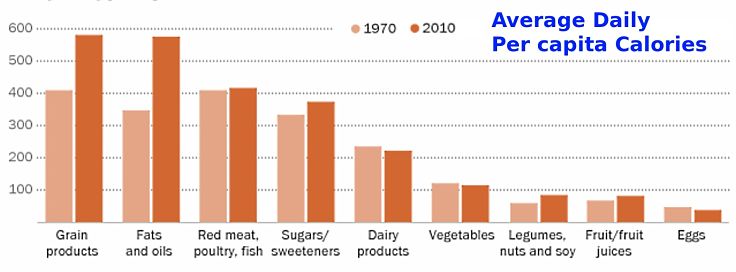
=> Many healthy vegetables we rely on today were simply unavailable. This includes foods like rocket, leafy greens, kiwifruit, limes, Lebanese cucumbers, eggplants, cherry tomatoes, and modern lettuce varieties other than iceberg.
=> There was less variety in the food stores as well - pasta was spaghetti, rice was plain white, sauce was tomato (ketchup), milk was straight from the cow. Many people grew their own vegetables and shopped virtually every day at the local shops, but there were no farmers markets or fresh produce stores.
=> There was very little chicken or other poultry available, except from hens and roosters kept the backyard for eggs.
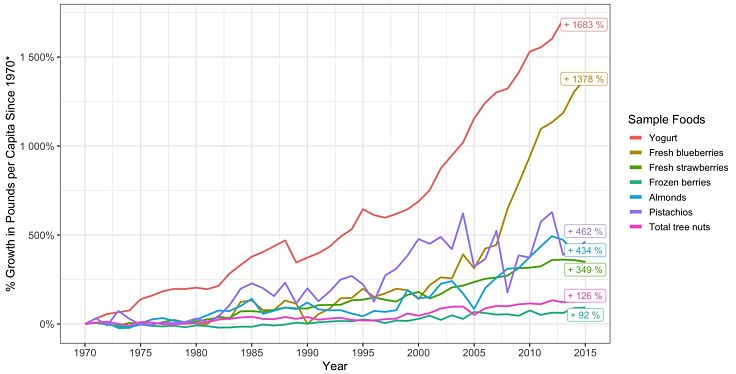
=> The variety that appeared in countries like Australia, UK and the United States came in the 1970s, 1980s and 1990s began with the influx of Italian, Greeks, Lebanese and immigrants from Asian countries into Australia and other countries. This migration transformed the tastes of the entire population.
=> The 1970s heralded a major surge in the production and widespread availability of cheap processed foods that were perceived as easy, trendy and accessible. However, this brought dietary changes that led to higher consumption rates for hidden fats, sugars and salt. It also meant reduced consumption of nutrients available in whole foods, that were lost through processing. Some key example are white flour vs wholemeal flour, white rice versus brown rice and the huge array of pasta based on white flours. By the 1980s the effects of this refined, more processed foods diet began to appear. There were increases in the obesity rate, and the rises in the prevalence of cardiovascular disease and diabetes in the population.
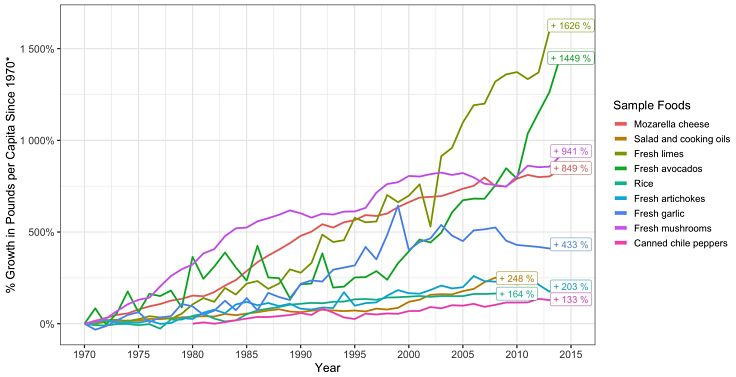
=> Proof that the so-called “Western diet” is the culprit for the alarming increase on obesity throughout the world lies in the way it has affected Polynesian countries. Many of these countries adopted the "Western diet" as a trend towards modernism and sophistication. The traditional diets which were akin to modern "Mediterranean Diet", rich in fish, seafood vegetables and fruit, were replaced by imported supermarket foods. The Western Diet is characterised by high intake of refined highly processed carbohydrates, added sugars, more fat and oils, and animal derived foods. Diets rich in legumes, other fresh whole vegetables, fruit and coarse whole-grains grains have been disappearing in many regions and countries throughout the world. Major global developments in food processing technologies, providing cheap processed products have been behind this shift on diets.
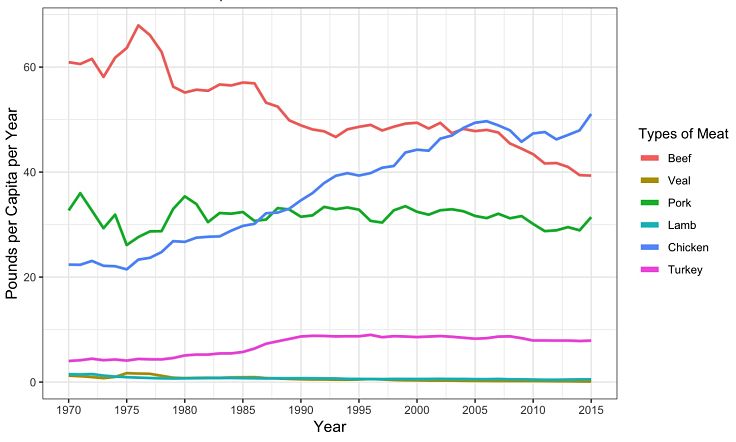
=> The edible vegetable oil revolution provided a cheap source of fats and oils which were added to processed food to enhance flavor and attractiveness of foods. Between 1985 and 2010 individual the overall annual consumption of vegetable oils increased 3-6 fold, depending on the sub-population throughout the world.
=> Rise in sugar and other caloric sweeteners added to high calorie intakes. It has been estimated that 75% of foods and beverages bought in the US contain added sugar and other caloric sweeteners. Today the average American consumes about 375 cal/day of sugar. Added sugar from beverages has increased significantly. In 1977–78 about 70% of the added sugar in the US diet originated from food. However, today 70% of the sugar consumed originates from beverages.
=> There has been a trend towards increased animal-source foods in Western Diets. The livestock revolution in the developing world has led to major increases in the production of pork, dairy products, beef, eggs, and poultry across low-and middle-income countries.
=> People now eat more chicken and poultry and less beef and pork than they used to.
=> People drink less fresh milk – especially whole milk. They also eat less ice cream than they used to.
=> People eat far more cheese, yogurt and other processed dairy foods.
=> People consume almost three times as much cooking oils as in the early 1970s.
=> People consume less pure sugar (sucrose) than previously, but a lot more corn-derived sweeteners.
=> The intake of legumes, coarse grains, and other vegetables has declined since the 1970s, replaced by processed carbohydrates.
=> People simply eat a lot more food each day, than people used to in the 1970s. The average US person consumed about 2,480 calories each day in 2010. This was about 25% more calories per day than in 1970. Current calorie consumption rates by most adults exceeds what people need to maintain their current weight, according to the Mayo Clinic’s estimates. Various calorie calculators estimate that a 40-year-old man of average weight and height, who is moderately healthy and active needs about 2,400 calories to maintain their weight. A 40-year-old woman with similar characteristics and lifestyle needs just 1,850 calories a day. Clearly most people simply eat too much in terms of calories consumed. Today, Almost half of the calories eaten are derived from just two types of food: Fats and oils (575 calories, or 23.2%) and Flours and grains (581 calories, or 23.4%). There is a simple solution to this - encouraging people to only eat the better half of the dishes they are served.
A Simple New Diet - Only Eat the Better Half